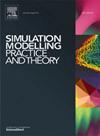Modelling of crowd evacuation behavior considering the effects of drunken gait
IF 3.5
2区 计算机科学
Q2 COMPUTER SCIENCE, INTERDISCIPLINARY APPLICATIONS
引用次数: 0
Abstract
The presence of drunk crowds complicates the evacuation process compared to sober crowds. We construct a Floor-Field Cellular Automata (FFCA) model considering the role of drunken pedestrian perturbations to investigate the impact of drunken gait on pedestrian dynamics. A random floor field is constructed to simulate the drunken gait of pedestrians, considering the role of surrounding pedestrians and the random movement behaviour of "drunken walk". A drunkenness factor is proposed to modulate the randomness of drunken gait, and a velocity model is formulated to account for the intermittent speed fluctuations observed in drunken pedestrians. In addition, a probabilistic model incorporating the coupled effects of drunkenness level and movement speed is proposed to address the pedestrian conflict. The FFCA model can reproduce some real features of the drunken evacuation process to some extent. For example, (1) Drunken pedestrian staggers while moving. (2) Blockage occurs at the gathering place of drunk pedestrians. (3) Drunken crowds are pushed to move by the flow of the crowd. The results show that drunken gait disrupts the orderly movement of pedestrians, whereas the presence of sober pedestrians can foster the formation of adaptive orderly behaviors, maintaining a orderly movement structure. When drunken pedestrians are located at the rear of the crowd flow, evacuation efficiency is higher in the early stage but the overall efficiency of the entire evacuation process is the lowest. Conversely, when distributed in the front and middle, although the gait of drunken people hinders in the early stage evacuation, sober pedestrians in the rear can act as guides and improve the overall evacuation efficiency.
考虑醉酒步态影响的人群疏散行为建模
与清醒的人群相比,醉酒人群的存在使疏散过程变得复杂。我们构建了考虑醉酒行人摄动作用的地板场元胞自动机(FFCA)模型来研究醉酒步态对行人动力学的影响。考虑到周围行人的作用和“醉走”的随机运动行为,构造一个随机地板场来模拟行人的醉酒步态。提出了醉酒因素来调节醉酒步态的随机性,并建立了一个速度模型来解释醉酒行人观察到的间歇性速度波动。此外,针对行人冲突问题,提出了一个考虑醉酒程度和运动速度耦合效应的概率模型。FFCA模型可以在一定程度上再现醉酒疏散过程的一些真实特征。例如:(1)醉酒行人行走时步履蹒跚。(二)醉酒行人聚集场所发生堵塞的。醉酒的人群被人流推着移动。结果表明,醉酒步态扰乱了行人的有序运动,而清醒行人的存在可以促进适应性有序行为的形成,维持有序的运动结构。当醉酒行人位于人群流的尾部时,早期的疏散效率较高,但整个疏散过程的整体效率最低。反之,当醉酒人群分布在前面和中间时,虽然醉酒人群的步态会阻碍前期疏散,但清醒的行人在后面可以起到引导作用,提高整体的疏散效率。
本文章由计算机程序翻译,如有差异,请以英文原文为准。
求助全文
约1分钟内获得全文
求助全文
来源期刊

Simulation Modelling Practice and Theory
工程技术-计算机:跨学科应用
CiteScore
9.80
自引率
4.80%
发文量
142
审稿时长
21 days
期刊介绍:
The journal Simulation Modelling Practice and Theory provides a forum for original, high-quality papers dealing with any aspect of systems simulation and modelling.
The journal aims at being a reference and a powerful tool to all those professionally active and/or interested in the methods and applications of simulation. Submitted papers will be peer reviewed and must significantly contribute to modelling and simulation in general or use modelling and simulation in application areas.
Paper submission is solicited on:
• theoretical aspects of modelling and simulation including formal modelling, model-checking, random number generators, sensitivity analysis, variance reduction techniques, experimental design, meta-modelling, methods and algorithms for validation and verification, selection and comparison procedures etc.;
• methodology and application of modelling and simulation in any area, including computer systems, networks, real-time and embedded systems, mobile and intelligent agents, manufacturing and transportation systems, management, engineering, biomedical engineering, economics, ecology and environment, education, transaction handling, etc.;
• simulation languages and environments including those, specific to distributed computing, grid computing, high performance computers or computer networks, etc.;
• distributed and real-time simulation, simulation interoperability;
• tools for high performance computing simulation, including dedicated architectures and parallel computing.
 求助内容:
求助内容: 应助结果提醒方式:
应助结果提醒方式:


